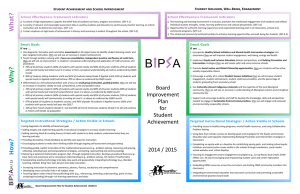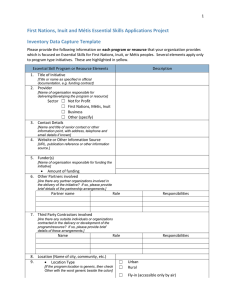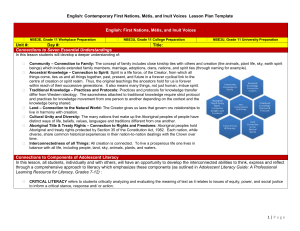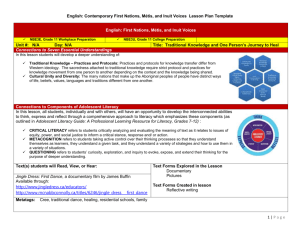Smart Goals Goals
advertisement
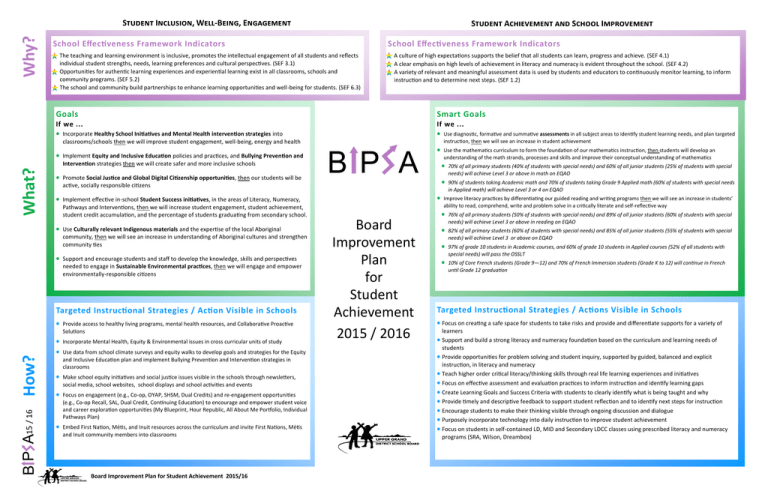
Why? Student Inclusion, Well-Being, Engagement Student Achievement and School Improvement School Effectiveness Framework Indicators School Effectiveness Framework Indicators The teaching and learning environment is inclusive, promotes the intellectual engagement of all students and reflects individual student strengths, needs, learning preferences and cultural perspectives. (SEF 3.1) Opportunities for authentic learning experiences and experiential learning exist in all classrooms, schools and community programs. (SEF 5.2) The school and community build partnerships to enhance learning opportunities and well-being for students. (SEF 6.3) A culture of high expectations supports the belief that all students can learn, progress and achieve. (SEF 4.1) A clear emphasis on high levels of achievement in literacy and numeracy is evident throughout the school. (SEF 4.2) A variety of relevant and meaningful assessment data is used by students and educators to continuously monitor learning, to inform instruction and to determine next steps. (SEF 1.2) Goals Smart Goals If we ... Incorporate Healthy School Initiatives and Mental Health intervention strategies into If we ... Use diagnostic, formative and summative assessments in all subject areas to identify student learning needs, and plan targeted classrooms/schools then we will improve student engagement, well-being, energy and health Implement Equity and Inclusive Education policies and practices, and Bullying Prevention and What? Intervention strategies then we will create safer and more inclusive schools Promote Social Justice and Global Digital Citizenship opportunities, then our students will be Pathways and Interventions, then we will increase student engagement, student achievement, student credit accumulation, and the percentage of students graduating from secondary school. community, then we will see an increase in understanding of Aboriginal cultures and strengthen community ties Support and encourage students and staff to develop the knowledge, skills and perspectives needed to engage in Sustainable Environmental practices, then we will engage and empower environmentally-responsible citizens Targeted Instructional Strategies / Action Visible in Schools Provide access to healthy living programs, mental health resources, and Collaborative Proactive Solutions Incorporate Mental Health, Equity & Environmental issues in cross curricular units of study Use data from school climate surveys and equity walks to develop goals and strategies for the Equity and Inclusive Education plan and implement Bullying Prevention and Intervention strategies in classrooms Make school equity initiatives and social justice issues visible in the schools through newsletters, social media, school websites, school displays and school activities and events Focus on engagement (e.g., Co-op, OYAP, SHSM, Dual Credits) and re-engagement opportunities (e.g., Co-op Recall, SAL, Dual Credit, Continuing Education) to encourage and empower student voice and career exploration opportunities (My Blueprint, Hour Republic, All About Me Portfolio, Individual Pathways Plan) Embed First Nation, Métis, and Inuit resources across the curriculum and invite First Nations, Métis and Inuit community members into classrooms Board Improvement Plan for Student Achievement 2015/16 Use the mathematics curriculum to form the foundation of our mathematics instruction, then students will develop an understanding of the math strands, processes and skills and improve their conceptual understanding of mathematics Implement effective in-school Student Success initiatives, in the areas of Literacy, Numeracy, instruction, then we will see an increase in student achievement active, socially responsible citizens Use Culturally relevant Indigenous materials and the expertise of the local Aboriginal B P A15 / 16 How? B P A 90% of students taking Academic math and 70% of students taking Grade 9 Applied math (60% of students with special needs in Applied math) will achieve Level 3 or 4 on EQAO Improve literacy practices by differentiating our guided reading and writing programs then we will see an increase in students’ ability to read, comprehend, write and problem solve in a critically literate and self-reflective way Board Improvement Plan for Student Achievement 2015 / 2016 70% of all primary students (40% of students with special needs) and 60% of all junior students (25% of students with special needs) will achieve Level 3 or above in math on EQAO 76% of all primary students (50% of students with special needs) and 89% of all junior students (60% of students with special needs) will achieve Level 3 or above in reading on EQAO 82% of all primary students (60% of students with special needs) and 85% of all junior students (55% of students with special needs) will achieve Level 3 or above on EQAO 97% of grade 10 students in Academic courses, and 60% of grade 10 students in Applied courses (52% of all students with special needs) will pass the OSSLT 10% of Core French students (Grade 9—12) and 70% of French Immersion students (Grade K to 12) will continue in French until Grade 12 graduation Targeted Instructional Strategies / Actions Visible in Schools Focus on creating a safe space for students to take risks and provide and differentiate supports for a variety of learners Support and build a strong literacy and numeracy foundation based on the curriculum and learning needs of students Provide opportunities for problem solving and student inquiry, supported by guided, balanced and explicit instruction, in literacy and numeracy Teach higher order critical literacy/thinking skills through real life learning experiences and initiatives Focus on effective assessment and evaluation practices to inform instruction and identify learning gaps Create Learning Goals and Success Criteria with students to clearly identify what is being taught and why Provide timely and descriptive feedback to support student reflection and to identify next steps for instruction Encourage students to make their thinking visible through ongoing discussion and dialogue Purposely incorporate technology into daily instruction to improve student achievement Focus on students in self-contained LD, MID and Secondary LDCC classes using prescribed literacy and numeracy programs (SRA, Wilson, Dreambox) BP A Data / Needs Assessment Professional Learning: Support for Schools EQAO Results—Grade 9, 10 (2015) and Grade 3, 6 (2014) : Mental Health Lead will facilitate the implementation of the Mental Health and Addiction Strategy, Mathematics: Board Improvement Plan for Student Achievement 2015 / 2016 Reading: (2014) Writing: (2014) Vision LEAD, LEARN, and INSPIRE together Mission B P A15 / 16 As leaders in our educational community we will develop student learning skills; foster achievement and wellbeing; and create a positive and inclusive environment. We will do this by Inspiring all voices, Learning through collaboration and Leading with confidence. Literacy: French: Graduation Rates: Grade 3: 60% of students at Level 3 or 4 30% of students with special needs at Level 3 or 4 Grade 6: 50% of students at Level 3 or 4 16% of students with special needs at Level 3 or 4 Grade 9: 88% of students in Academic Math at Level 3 or 4 59% of students in Applied Math at Level 3 or 4 53% of students with special needs at Level 3 or 4 66% of students at Level 3 or 4 38% of students with special needs at Level 3 or 4 Grade 3: Grade 6: 79% of students at Level 3 or 4 49% of students with special needs at Level 3 or 4 Grade 3: 72% of students at Level 3 or 4 52% of students with special needs at Level 3 or 4 Grade 6: 75% of students at Level 3 or 4 43% of students with special needs at Level 3 or 4 Grade 10: 95% of Grade 10 students in Academic English were successful 55% of Grade 10 students in Applied English were successful 7.1% (an increase of 2.9%) of Core French students (Grade 9—12) and 65.8% (an increase of 22.8%) of French Immersion students (Grade K—12) graduated from Grade 12 with French Increase 4 year graduation rate to 73% Increase 5 year graduation rate to 87% offer workshops, professional collaborative PD opportunities with community agencies and develop the vision for mental health and addictions programs and services Equity Lead will provide ongoing education and training to increase awareness in Equity issues for Staff, Trustees and Administration to ensure inclusive education Board Leadership Development Strategy goals will align the focus of Principal Learning Teams, Annual Learning Goals and Principal Performance Appraisals with BIPSA strategies to concentrate priorities and build capacity amongst school and system leaders Student Support and Program Services department and Central board staff will support teacher professional learning that aligns with the BIPSA and SIPSA, and facilitate capacity building, collaborative inquiry/planning and teaching in all subject areas, within and between schools Technology department will provide research reports and key data to school leaders to assist in measuring student achievement First Nations, Métis and Inuit Lead will support and encourage staff to support the academic achievement of First Nations, Métis and Inuit students through culturally relevant programming and assessment and evaluation strategies Environmental Lead will implement the Environmental Sustainability Action Plan and provide regular communication, updates and support to staff to educate environmentally-responsible citizens School Effectiveness Lead will provide instructional direction to staff, and implement the School Self-Assessment across the system, as a measure of the implementation of best practices Accountability: Monitoring of Schools Teachers Conduct assessment For, As and Of Learning in order to inform instructional practices Develop, implement and monitor IEPs Collect and analyze diagnostic assessments and other student data (e.g., Student Profiles, At Risk surveys) to target needs, plan instruction and monitor progress and input this data into Compass for Success Principals Submit School Improvement Plans to Superintendents in January, 2016 Conduct Learning Walks to monitor instructional strategies, student engagement, and evidence of the SIPSA and conduct Equity Walks to reflect on the impact of Equity initiatives Lead and participate with staff in Professional Learning (e.g., Capacity Days, PLCs, BIP, Mental Health , NTIP, Environmental and Social Justice) Monitor IEPs using the IEP engine, and the use of diagnostic assessments using Compass for Success Track 4 and 5 year graduation rates and achievement in applied courses including data for First Nations, Métis and Inuit Students, and Youth in Care Superintendents Review, discuss and monitor classroom implementation of the SIPSA, 5 Year Professional Learning Plan, and school specific work in math and language at fall, mid year, and spring visits Review, discuss and monitor classroom implementation of the SRA and Wilson programs in LD, MID, and LDCC classes, at fall, mid year, and spring visits Review, discuss, and monitor the Memorandums of Withdrawal from French Immersion schools Monitor 4 and 5 year graduation rates and achievement in applied courses, including data for First Nations, Métis and Inuit Students and Youth in Care System Level Mental Health & Addictions Lead: monitor the use and staff awareness of mental health resources (e.g., Collaborative & Proactive Solutions, Supporting Minds), and training (e.g., ASIST, safeTALK) Superintendent of Student Support and Program Services and Superintendent of Student Success: review, monitor, and support the SRA, Wilson, and Dreambox programs Superintendent of Student Support and Program Services: collaborate with program staff to ensure the goals of the Special Education Plan, student supports, student profiles and effective ISTs and CSTs are being effectively implemented across the district Superintendents of Education: review Student Engagement and Student Achievement Data and monitor Action Plans with Principals throughout year Superintendents of Education: monitor Principal Performance Appraisal goals and ensure alignment with the Ontario Leadership Framework and the BIPSA Superintendents of Education: ensure the Safe, Equitable and Inclusive Education plan is in place Superintendents of Education: monitor 4 and 5 year graduation rates and achievement in applied courses, including data for First Nations, Métis and Inuit Students and Youth in Care School Effectiveness Lead: conduct District Support Visits and monitor the overall trends of evidence of the implementation of School Effectiveness Framework indicators throughout the Board Board Improvement Plan for Student Achievement 2015/16
